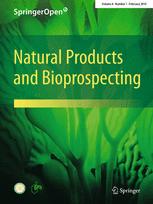|
|
The Chemistry and Biological Activities of Natural Products from Northern African Plant Families: From Taccaceae to Zygophyllaceae
Collect
Fidele Ntie-Kang, Leonel E. Njume, Yvette I. Malange, Stefan Günther, Wolfgang Sippl, Joseph N. Yong
Natural Products and Bioprospecting. 2016, 6 (2): 63-96.
DOI: 10.1007/s13659-016-0091-9
Traditional medicinal practices have a profound influence on the daily lives of people living in developing countries, particularly in Africa, since the populations cannot generally afford the cost of Western medicines. We have undertaken to investigate the correlation between the uses of plants in Traditional African medicine and the biological activities of the derived natural products, with the aim to validate the use of traditional medicine in Northern African communities. The literature is covered for the period 1959-2015 and part III of this review series focuses on plant families with names beginning with letters T to Z. The authors have focused on curating data from journals in natural products and phytomedicine. Within each journal home page, a query search based on country name was conducted. All articles ''hits'' were then verified, one at a time, that the species was harvested within the Northern African geographical regions. The current data partly constitutes the bases for the development of the Northern African natural compounds database. The review discusses 284 plant-based natural compounds from 34 species and 11 families. It was observed that the ethnobotanical uses of less than 40% of the plant species surveyed correlated with the bioactivities of compounds identified.
References |
Related Articles |
Metrics
|
|
|
Lanostane Triterpenoids from Fruiting Bodies of Ganoderma leucocontextum
Collect
Zhen-Zhu Zhao, He-Ping Chen, Ying Huang, Zheng-Hui Li, Ling Zhang, Tao Feng, Ji-Kai Liu
Natural Products and Bioprospecting. 2016, 6 (2): 103-109.
DOI: 10.1007/s13659-016-0089-3
Six new lanostane-type triterpenoids, namely leucocontextins S-X (1-6), together with twelve known compounds, were isolated from the fruiting bodies of Ganoderma leucocontextum. Their structures were established by MS and NMR data.
References |
Related Articles |
Metrics
|
|
|
Total Synthesis of Dimeric HPI Alkaloids
Collect
Xianfu Shen, Yongyun Zhou, Yongkai Xi, Jingfeng Zhao, Hongbin Zhang
Natural Products and Bioprospecting. 2016, 6 (2): 117-139.
DOI: 10.1007/s13659-016-0092-8
In this paper, we report a full account of the synthesis of dimeric hexahydropyrroloindole alkaloids and its analogues. The key feature of our new strategy is the novel catalytic copper (10%) mediated intramolecular arylations of o-haloanilides followed by intermolecular oxidative dimerization of the resulting oxindoles in one pot. This sequential reaction leads to the key intermediates for the synthesis of (+)-chimonanthine, (+)-folicanthine, (-)-calycanthine and (-)-ditryptophenaline. Graphical Abstract In the presence of catalytic amount of cuprous iodide (10%), an intramolecular arylation of ohaloanilidesfollowedby an intermolecularoxidative dimerizationof the resultingoxindolesleads to a commonintermediatefor the synthesis of (+)-chimonanthine, (+)-folicanthine and (-)-calycanthine. Based on this cascade sequence, we also developed a flexible strategy towards the asymmetric syntheses of dimeric HPI alkaloids (-)-ditryptophenaline and its analogues.
References |
Related Articles |
Metrics
|
|
|
Inhibition of DNA-Topoisomerase I by Acylated Triterpene Saponins from Pittosporum angustifolium Lodd
Collect
Christian Bäcker, Malgorzata N. Drwal, Robert Preissner, Ulrike Lindequist
Natural Products and Bioprospecting. 2016, 6 (2): 141-147.
DOI: 10.1007/s13659-016-0087-5
Previous phytochemical investigation of the leaves and seeds of Pittosporum angustifolium Lodd. led to the isolation and structural elucidation of polyphenols and triterpene saponins. Evaluation for cytotoxicity of isolated saponins revealed that the predominant structural feature for a cytotoxic activity are acyl substituents at the oleanane aglycon backbone. The present work reports the results of a screening of 10 selected acylated saponins for their potential to inhibit the human DNA-topoisomerase I, giving rise to IC50 values in a range of 2.8-46.5 μM. To clarify the mode of observed cytotoxic action and, moreover, to distinguish from a pure surfactant effect which is commonly accompanied with saponins, these results indicate an involvement of the topoisomerase I and its role as a possible target structure for a cytotoxic activity. In addition, computational predictions of the fitting of saponins to the topoisomerase I-DNA complex, indicate a similar binding mode to that of clinically used topoisomerase I inhibitors.
References |
Related Articles |
Metrics
|
|

